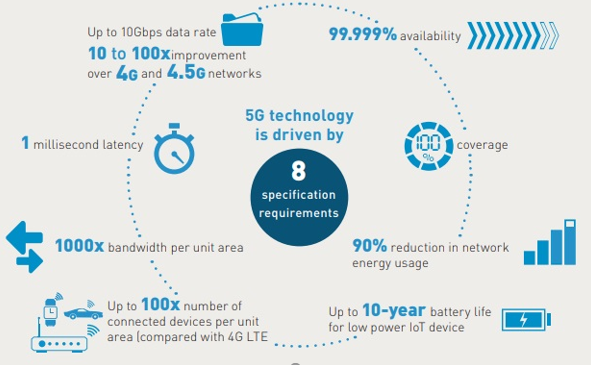
Imagine a world where gadgets, people, infrastructure, and buildings talk to each other. In this advanced world, which we have often seen in sci-fi movies, surgeries are conducted by doctors from thousands of miles away. Cars are driven without a driver. You can interact with factories, buildings, and cities and can even watch live events in VR!
Yes! That’s exactly what our world will become with the inception of 5G technology – secure, experiential and hyper-connected.
Fascinating! Isn’t it?
Contents
What is 5G capable of?

Considering the zealous acceptance of 5G technology by the governments and the industry as a whole, it’s no doubt that we are on the brink of a technological revolution. Invented with the aim to assist wireless networks to cope up with the congested data traffic, 5G technology will be a game-changer. It will lead to innovations such as control of driverless vehicles, remote surgery, and more.
5G is the fifth generation of mobile technology that ensures faster streaming, browsing, and download speeds along with better connectivity. It is also designed for increasing capacity and reducing latency, i.e. the time taken for devices to communicate with each other. These changes will play a huge role in our capacity to adopt 5g technology into our day-to-day lives, especially for integrated applications such as self-driving cars, robotics, and medical devices.
The 5G technology, however, has become controversial, with many people and a few scientists articulating concerns with regards to the possible side effects of RF energy transmitted by 5G base stations.
What makes 5G different?
With technologies such as 4G, connectivity has been restricted from humans to the internet and humans to humans. However, with 5G network, things will go far beyond, and one can imagine the connection of not just devices and machines to humans but also machines with other machines. 5G network promises a completely connected experience. It is estimated that the number of connected devices across the globe will triple to 25.4 billion by 2030. With that happening and unlocking of 5g internet, terms such as virtual reality, internet of things, and artificial intelligence will no longer be just fancy connotations but something common.
3GPP (3rd Generation Partnership Project) believes in the power of 5G due to its three major applications:
- Ultra-reliable, low latency communication (URLLC)
- Enhanced mobile broadband (EMBB)
- Massive machine type communication (MMTC)
Does 5G technology impact health?
There is significant data available on the health effects of electromagnetic waves with inconsistent results. However, the data or research available on the frequencies used in 5G is limited, as per World Health Organization (WHO). Electromagnetic waves have been associated with the following associated risks:
Tissue heating –
According to a study conducted in 2017 by WHO, the frequencies used by mobile phones (which are 1.8 to 2.2 GHz) can cause tissue heating. This is a result of the skin absorbing electromagnetic energy, causing a rise in the temperature of your body and brain. It has also been found that EMF-associated tissue heating is more common in the elderly. This is probably the reason that older individuals have reduced blood flow and skin thickness. However, the frequency of EMF is low enough to cause any considerable tissue heating, according to the Federal Communications Commission. There is a need for more research with regards to the effect of the 5G internet on human tissue.
Cognitive function –
There was a study conducted on how mobile usage can affect cognitive function in 2017, which revealed that using a mobile phone for 90 minutes can lead to attention difficulties. In a similar study conducted in 2018, researchers examined 43 studies concerning cognitive function and EMFs and found the previous evidence conflicting. It was established that there is no substantial link between cognitive concerns and electromagnetic fields. There is no study on the effects of 5G technology on cognitive function.
Cancer –
EMFs were considered ‘possibly carcinogenic’ to humans according to the International Agency for Research on Cancer (IARC) in 2011. Many studies were conducted later on to examine the potential link between brain cancer and EMFs. However, the results haven’t been consistent. EMF radiations from mobile phones were linked with a type of brain cancer (glioma), for instance, in a 2017 research. However, the association between the two couldn’t be established clearly in a 2018 study. There is a need for more studies to find if 5G frequency can lead to the development of cancer.
False Claims Concerning Health Risks
Numerous false claims about the implication of 5G on health have been made since its advent. Some of these are:
- 5G causes migraines, headaches, and dizziness
- There are 5G microchips in COVID-19 vaccines
- COVID-19 pandemic is being covered up with the release of 5G
There is no substantial proof behind these false claims.
The Bottom Line
While there is small evidence that ties RF-EMF to an increase in the risk of cancer development and associated health outcomes, there’s no conclusion on how serious a threat is 5G technology exposure and EMFs in general. There’s no escape from radio waves for those staying in densely populated areas. The exposure can be reduced by limiting cell phone usage and creating a distance between devices and our heads. With no substantial evidence supporting the false health concerns claims, there’s no reason to neglect 5G and its amazing benefits.














